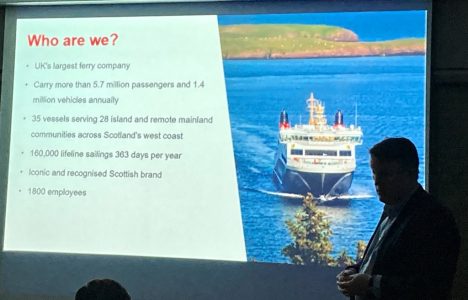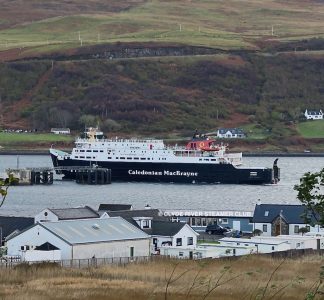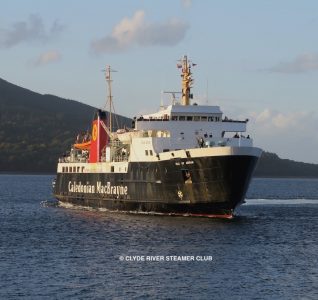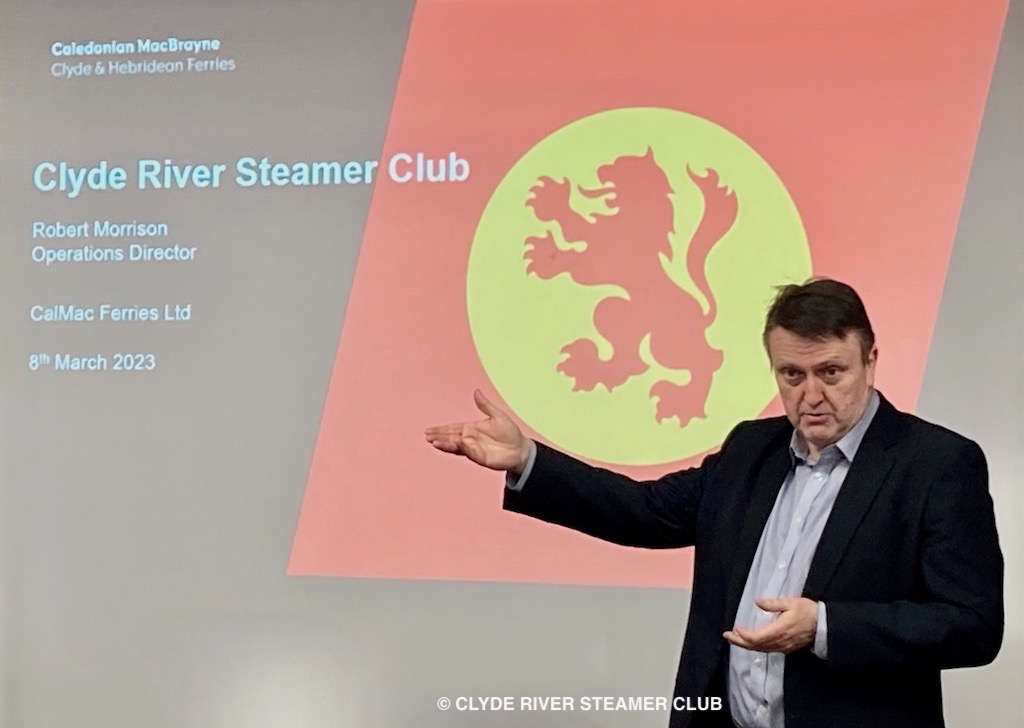
Robert Morrison: ‘CalMac is in a tough place right now, but the job I have is in my heart, and I am not alone’
‘Is it perfect? No, it’s not.’ Robert Morrison’s acknowledgement of CalMac’s less-than-perfect performance was, ironically, the perfect way to win over the audience at his latest CRSC presentation. As Director of Operations for CalMac Ferries Ltd, he deals with crises and criticisms on a daily basis — and yet, the more he told us about the challenges of his job, the more he oozed positivity and persuaded us that the west coast ferry operator has ‘turned a corner’. He was welcomed into our midst like an old friend, and given a rapturous round of applause at the end.
Click here to access a video of the 70-minute presentation, including a lively question-and-answer session at the end.
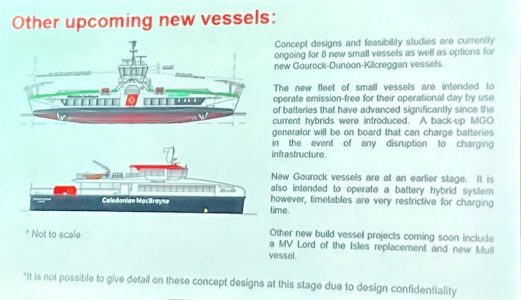
Among the new vessels due to join the west coast fleet in coming years are eight replacements for the ‘Loch’ class and three new battery-hybrid ferries for Gourock-Dunoon-Kilcreggan
The underlying theme of Robert Morrison’s characteristically candid and engaging talk in Glasgow on 8 March was that, after the disruption of the pandemic and delays to the 2022-23 overhaul programme, CalMac is back on the front foot. Thanks to an ever-so-subtle campaign over the past couple of years, the company is changing public perceptions about who ultimately bears responsibility for west coast ferry woes: the service provider can only work within the multiple constraints imposed by the Scottish Government, Transport Scotland and Caledonian Maritime Assets Ltd.
Robert did not minimise the challenges CalMac faces — abuse of staff, an ageing fleet, lack of spare tonnage — but he offered plentiful grounds for optimism: ‘There is a hell of a lot in the pipeline.’
Among the developments he outlined were:
- a new e-ticketing system, due to roll out on Tuesday 25 April, giving everyone the opportunity to buy tickets online in advance
- an eight-part televised documentary series on BBC Scotland (from May), providing a ‘warts and all’ portrait of CalMac that will emphasise the company’s human face
- an enhanced role for the Falls Park parts storage facility in Gourock, to compensate for minimal maintenance time available under hours of work regulations while ships are in constant service
- greater standardisation of vessel design, making for economies of scale, easier maintenance and greater interchangeability
- a five-year pairing of vessels with individual shipyards, designed to promote a better understanding of each vessel’s annual overhaul needs
- a replacement for Lord of the Isles on the Lochboisdale service by March 2027
- a new Mull ferry for October 2027
- a roll-out of eight new small ferries between November 2025 and March 2028, as replacements for the ‘Loch’ class
- the commissioning of three new battery-hybrid vessels for Gourock-Dunoon-Kilcreggan, each of similar design
- upgrades to 14 ports over the next six years, including an overnight berth for the Iona ferry at Fionnphort to replace the Bull Hole, currently ‘one of the biggest risks in our fleet’ because of its reliance on a dinghy-type boat to bring crewmen ashore (this project depending on cooperation with Argyll and Bute Council).
As for the four new ferries under construction in Turkey (two for Islay by February 2025, two for the Little Minch by October 2025), Robert said their design would incorporate Voith units for increased manoeuvrability. The superstructure would have ‘a lot of glass’ to make passenger accommodation ‘more light and airy’.
With ships like Hebrides currently ‘maxed out’, the introduction of four new ferries would have a knock-on benefit for the whole fleet, with Hebrides and Finlaggan due for redeployment — though it was too early to say on which routes.
These plans represented ‘light at the end of the tunnel.’ CalMac Ferries Ltd still had a year of its eight-year contract to run, and ‘the likelihood is an extension — but it needs to be on different terms. The world has moved on [as a result of the pandemic and fuel price increases], and these discussions are ongoing.’
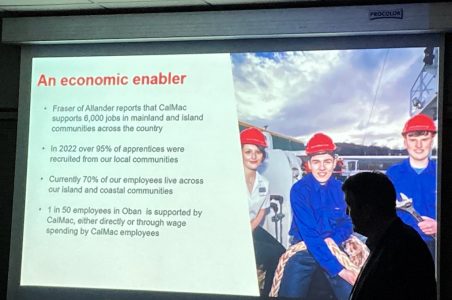
CalMac’s apprentice scheme has won plaudits, helping to embed the company in the communities it serves
He said CalMac was a company ‘of so many moving parts’. Few of its critics understood that ‘a separate company owns the assets. We have to work within the confines of our remit. We are now in a better place as a business at being able to defend the part that is ours.’
Acknowledging that Isle of Arran had been CalMac’s ‘saving grace’ in recent months, he said she and Hebridean Isles could be expected to continue in service until the new ferries had settled in.
As for Clansman, Caledonian Isles and other workhorses, the stresses of year-round service meant onboard maintenance was being squeezed and the dry dock season was becoming longer and longer.
This year it had been discovered that Caledonian Isles required ‘significant steelwork’ but, against expectation, Isle of Lewis did not need similar attention.
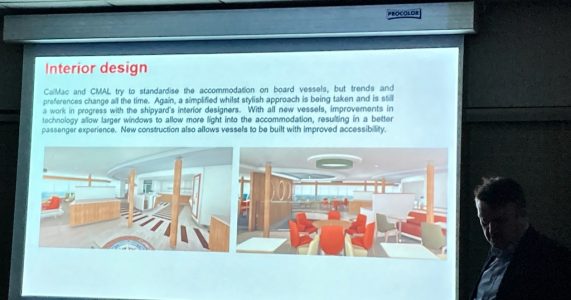
The new ferries under construction in Turkey (two for Islay, two for the Little Minch) will have ‘a lot of glass’ to make passenger accommodation ‘more light and airy’
Referring to the two scandal-ridden ferries under construction at Port Glasgow, Robert indicated that the official entry-into-service dates for Glen Sannox and Yard No. 802 (May this year and next February respectively) were ‘not likely to happen — we’re expecting further delay.’
On the subject of short-term charters to alleviate pressure on particular routes, he said CalMac had no ideological objection to catamaran design: it was Pentalina’s owners who had broken off recent charter negotiations. ‘Discussions are ongoing: this is something that is likely to take place, because we are stretched to our limit. If a catamaran can do a job for us, I wouldn’t argue against it. Anything would be a bonus.’
Robert’s fluent PowerPoint presentation included data charts, video clips and well-illustrated fact sheets, but much of what he said was ‘straight from the hip’. He acknowledged that Loch Seaforth was struggling to maintain her service speed, and said islanders’ frustration over CalMac’s service quality was understandable. ‘If I lived on an island, I’d feel the same way.’ He spoke of the difficulties of constantly having to ‘rejig’ the service over the past winter: crisis management had become a daily occurrence, and it was hardly surprising that some staff were suffering from burnout.
‘We have to be honest with people about the challenges we face, rather than trying to hide,’ he said. ‘We need to show empathy with the travelling public. CalMac is going through troubled times just now, but I’m proud of the way everyone has pulled together.’
Report and photography by Andrew Clark
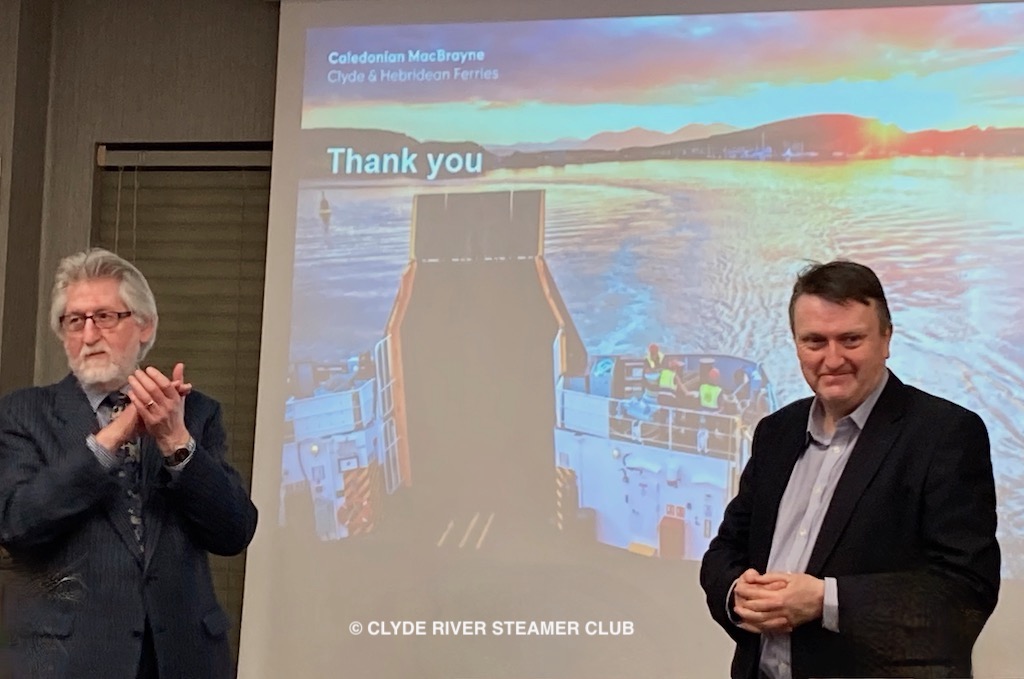
CRSC Vice-President Jim Stirling (left) thanked Robert Morrison for sparing the time to address the Club amid a hectic CalMac work schedule. This was Robert’s second CRSC presentation in just over three years: his previous visit was in January 2020, three months before lockdown
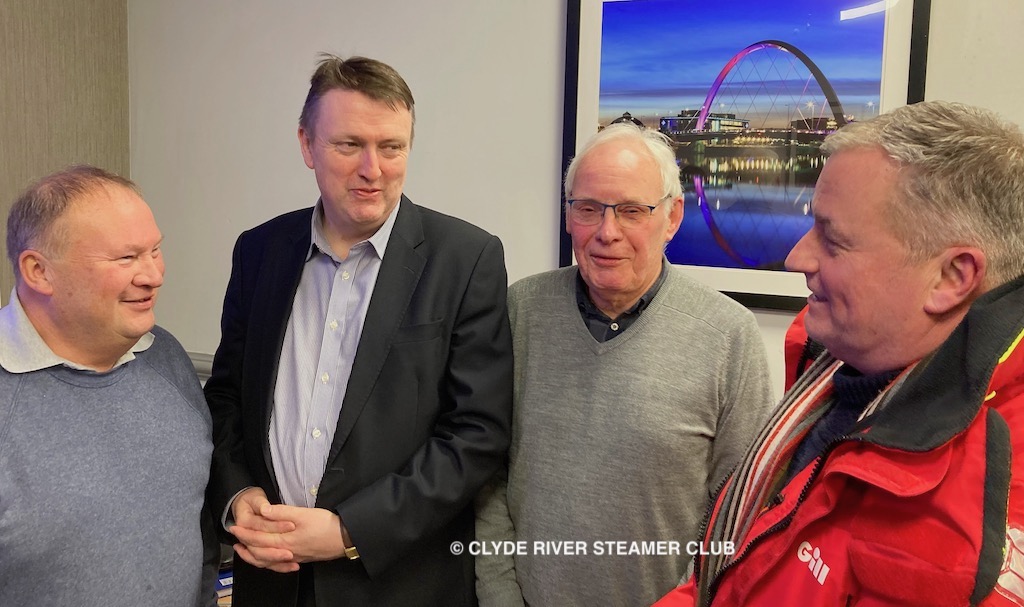
Many members and friends came to the front of the meeting room to congratulate Robert Morrison (second left) after his presentation. They included engineer Alex Forrest (left), who helped to prepare Loch Frisa for UK service; naval architect Alex Wright (second right), who played a pivotal role in the design of Coruisk, Bute and Argyle; and CalMac area operations manager Don McKillop (right), who contributed to the question-and-answer session at the end of Robert’s presentation
SEE ALSO Robert Morrison: Delivering CalMac Services (January 2020)
Join CRSC and share your enthusiasm for ships with like-minded people. A first-year subscription costs £10 and brings full benefits, including the annual Review of west coast shipping, reduced-price offers, a 54-page magazine and access to photo-rich ‘Members Only’ posts. Click here now.
Published on 11 March 2023












